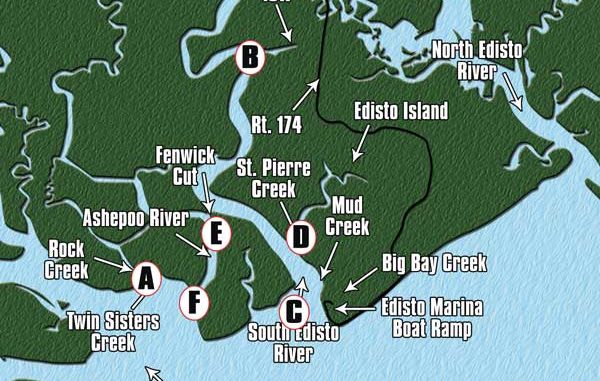
Edisto area offers shrimp-baiters a myriad of opportunities to fill their coolers.
South Carolina’s shrimp-baiting season began its 60-day run at noon on Sept. 11, so the season is in full swing already.
If that isn’t a good-enough reason to visit the Edisto area, you’ll never find one, because the vast area between Charleston Harbor and the Hilton Head/Beaufort area literally teems with shrimp. It is among the most-productive areas of South Carolina’s coastline.
Withe the cooling weather, shrimp will head from their nursery areas in the marshes toward the ocean. Intercepting them along the way can lead to many delicious meals, but it’s a matter of knowing when and where shrimp can be found in good numbers.
Toss in some good bait balls, and the only thing limiting your catch is your ability to throw a cast net.
The Edisto area is literally packed with places where you can fill your cooler with a daily limit of 48 quarts of (heads-on) shrimp. Here is a sampling of spots that persons unfamiliar with the area might try:
• The mud flat where Big Bay Creek joins Mud Creek just down from the Edisto Marina. From the Edisto River side of the flat on up to the sand bar beyond the red No. 4 channel marker.
A word of caution: the mud flat at the mouth of Mud Creek is pluff mud and will be high and dry at low tide. If you stay too long and get grounded, you’ll have to wait a full six hours before high water floats you off. A sandbar on the right before you reach the No. 4 marker will require two hours of rising water after low tide to cross. From the side of the sandbar to the marsh grass is a great place to shrimp; most will be medium-sized, with a sprinkling of larges and jumbos.
• St. Pierre Creek is the first major creek on the right after you pass the No. 4 marker. The first 100 yards on the right hand side of the creek is a good spot. When leaving Big Bay Creek, veer left toward the ocean when headed to the No. 2 red, triangular channel marker to avoid a sandbar that’s in play the first two hours after low tide. It will keep you from going any farther upstream.
• The junction of the Edisto River and ICW, past St. Pierre Creek, gets you in another good neighborhood. Turn left into Fenwick Cut and left again where it joins the Ashepoo River. A quarter-mile down the Ashepoo, there will be a boat dock on the left. Across the river, down the side of the grass will be good shrimping. The best action there is 1½ hours before high tide on through the high tide. Put your poles right against the grass! Shrimp numbers will be high, but size will be mostly small and medium, with occasional larges and jumbos.
• Continue down the Ashepoo River to St. Helena Sound. A red triangular channel marker will be on the left. A green triangular channel marker will be off to the right several hundred yards. Anywhere in this area is good. Find flats bordered by creek channels that hold eight to 10 feet of water at high tide. Shrimp size is excellent, with many jumbo and prawn shrimp in the catch.
• Two other good locations are the channels in Twin Sisters and Rock creeks. St. Helena Sound is a wide and varied area, offering outstanding shrimping; it is full of creek channels, humps and drop-offs. Look for concentrations of boats identifying shrimpers. Don’t crowd another shrimpers; there’s plenty of room for everybody.
Tidal creeks and rivers, and open sounds or flats are the main places where shrimp are caught over bait. Shrimp caught in creeks and rivers are generally smaller than those caught in the open water. If you can locate an area that holds nine feet of water at high tide and is adjacent to a creek channel or dropoff, you’re usually in business. On low tide, try to stay in a minimum of three feet of water. If you can do that and shrimp a shallow area close to deeper water, that’s even better.
When shrimping at night, water clarity is not normally a problem. When shrimping during daylight hours, shrimp are extremely skittish in clear water; it’s best to have muddy or roiled water conditions.
Both times have their pros and cons. During the day, it’s much easier to navigate. The downside is the hot sun, and the water needs to have a little color for the best success. At night, it’s much cooler, and shrimp are not nearly as skittish, but it’s more difficult to pinpoint your spots.
Shrimp are attracted to bait like flies to sugar. Most shrimpers will place bait balls in the same location in front of each of their shrimping poles. A net with a radius of at least five feet is the ticket, so placing your bait about six feet from your poles allows you to cover the most productive area with a single cast.
Wind and tide will determine which side of your poles you place the bait. It is much easier to throw a net downwind. To get maximum results from your bait, it needs to be placed 90 degrees from the flow of the tide. As your bait ball melts, a scent stream will travel down tide. Poles and bait set in a line with the flow of the tide will only have one scent stream as opposed to 10 scent streams from poles and bait placed 90 degrees to the tide.
Most shrimpers mix their bait before actually going out to shrimp. Bait balls should range from baseball- to softball-sized. The balls are then flattened to keep them from rolling with the tide.
Jake Alverez of Rock Hill likes to make his bait mixture and store it in bulk in a 5-gallon bucket. When it comes time to bait the poles, he scoops out a large handful of bait and molds it into a ball. This ball is then flattened, and dropped in the water in front of a pole. This procedure is followed until all of his poles are baited. Rebating is done when the harvest of shrimp slows.
A basket with a capacity of about a bushel that has drain holes in it is ideal to deposit your catch after each cast. The late Dr. Jim Holler of Rock Hill, an expert Edisto shrimper, liked to set his basket in a wash tub to keep excess water from collecting in the boat.
“At the end of each run of your poles, dump your catch into a cooler that has ice in it to keep your shrimp fresh,” he said.
The daily limit is 48 quarts of shrimp (heads on) or 29 quarts (headed).

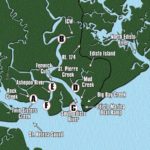
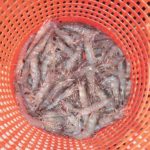
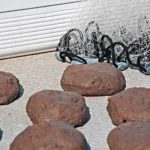
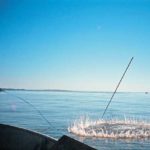
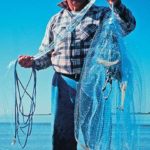
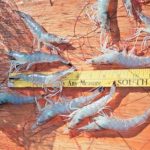


Be the first to comment